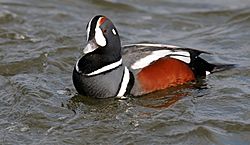Merginae facts for kids
Quick facts for kids Sea Ducks |
|
|---|---|
 |
|
| Harlequin Duck, Histrionicus histrionicus (male) | |
| Scientific classification | |
| Kingdom: | |
| Phylum: | |
| Class: | |
| Order: | |
| Family: | |
| Subfamily: |
Merginae
|
Sea ducks are a fascinating group of birds that belong to the same family as ducks, geese, and swans. Most of these birds spend their lives in the ocean, especially when they are not raising their young. They are known for their amazing ability to dive deep underwater to find food.
Many sea ducks have a special body part called a salt gland. This gland helps them drink salty ocean water without getting sick. It removes the extra salt from their bodies. However, young sea ducks do not have these glands fully developed yet. While most sea ducks love the ocean, some kinds prefer to live in rivers and other freshwater places.
Contents
What are Sea Ducks?
Sea ducks are part of a group of birds called Merginae. This group includes many different types of ducks. They are well-known for living near or in the ocean for most of the year. These birds are strong swimmers and excellent divers.
Where do Sea Ducks Live?
Sea ducks live in many parts of the world. You can find them in cold northern areas, like the Arctic. They also live along the coasts of North America, Europe, and Asia. During the breeding season, many sea ducks move to freshwater lakes and rivers. This is where they build their nests and raise their ducklings.
Ocean Homes
When it is not breeding season, sea ducks often gather in large groups on the ocean. They prefer coastal waters, bays, and estuaries. These areas offer plenty of food and protection. Some species even spend their winters far out at sea.
Freshwater Breeding Grounds
Even though they are called "sea ducks," many species need freshwater for nesting. They choose quiet lakes, ponds, and slow-moving rivers. These freshwater spots provide safe places for their eggs and young. The ducklings can find insects and small plants to eat in these areas.
Amazing Adaptations of Sea Ducks
Sea ducks have special features that help them survive in their watery homes. These adaptations allow them to dive, swim, and live in salty environments.
How do Sea Ducks Dive?
Sea ducks are expert divers. They can stay underwater for a long time. Some species can dive very deep to catch their food. They use their strong feet to push themselves through the water. Their bodies are streamlined, which means they are shaped to move easily underwater.
Finding Food Underwater
Most sea ducks eat food they find underwater. Their diet includes shellfish like mussels and clams. They also eat crabs, small fish, and other water creatures. Some sea ducks have special bills that help them grab slippery fish. Others have strong bills to crush shells.
Salt Glands: A Special Feature
One of the most important adaptations for sea ducks is their salt gland. This gland is located near their eyes. It works like a tiny filter. When a sea duck drinks salty water, the salt gland removes the extra salt. The salt then comes out as a salty liquid from their nostrils. This allows them to stay hydrated even when drinking ocean water.
Young Ducks and Salt Water
Baby sea ducks, called ducklings, do not have fully developed salt glands. This means they cannot drink salty water right away. Because of this, mother ducks often lead their ducklings to freshwater areas. They stay there until the ducklings are old enough to handle salt water. This is why freshwater breeding grounds are so important for sea ducks.
Different Types of Sea Ducks
The Merginae subfamily includes several well-known types of ducks. Each type has its own unique look and habits.
- Eiders: These are large, heavy-bodied ducks. They are famous for their soft, warm down feathers. People used to collect eiderdown to fill warm blankets and coats.
- Scoters: Scoters are dark-colored ducks often seen in large flocks on the ocean. They are known for their thick, strong bills.
- Goldeneyes: These ducks have bright yellow eyes, which gives them their name. They are fast flyers and often nest in tree cavities.
- Buffleheads: Buffleheads are small, compact ducks. Males have a striking black and white pattern on their heads.
- Mergansers: Mergansers have long, thin bills with serrated (saw-like) edges. This helps them catch fish. They are sometimes called "sawbills."
- Harlequin Ducks: These are colorful ducks with unique patterns. They prefer fast-flowing rivers during the breeding season.
Life Cycle and Reproduction
Sea ducks have an interesting life cycle. They travel long distances to find mates and raise their young.
Nesting and Eggs
After migrating to their breeding grounds, female sea ducks build nests. Nests are often hidden in dense plants near water. They lay a clutch of eggs, usually between 5 and 10. The eggs are typically a pale color.
Raising Ducklings
The female duck incubates the eggs, meaning she sits on them to keep them warm. After about a month, the ducklings hatch. They are covered in soft down feathers. Ducklings can swim and find food almost immediately after hatching. The mother duck protects them and teaches them how to survive.
Fledging and Independence
As the ducklings grow, they develop their flight feathers. This process is called fledging. Once they can fly, they become more independent. They will soon join other young ducks and prepare for their first migration to the ocean.
Conservation of Sea Ducks
Like many wildlife species, sea ducks face challenges. Their habitats can be affected by pollution and changes in the environment. Scientists and conservation groups work to protect sea ducks and their homes. This includes studying their migration patterns and ensuring their breeding and wintering grounds are safe.

